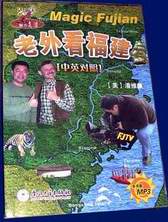![]() Click
to
Access
Click
to
Access
OUTSIDE China
![]() Click
to Access
Click
to Access
INSIDE
China ![]()
TRAVEL LINKS
![]() Xiamen
Xiamen
![]() Gulangyu
Gulangyu
![]() Jimei
Jimei
![]() Tong'an
Tong'an
![]() Jinmen
Jinmen
![]() Zhangzhou
Zhangzhou
![]() Quanzhou
Quanzhou
![]() Wuyi
Wuyi
![]() #1Fujian
Sites!
#1Fujian
Sites!
![]() Fujian
Foto Album
Fujian
Foto Album
![]() Books
on Fujian
Books
on Fujian
![]() Readers'Letters
Readers'Letters
![]() Ningde
Ningde
![]() Zhouning
Zhouning
![]() Longyan
Longyan
![]() Sanming
Sanming
![]() Putian
Putian
![]() Bridges
Bridges
![]() Travel
Info,
Travel
Info,
![]() Hakka
Roundhouses
Hakka
Roundhouses
![]() Travel
Agents
Travel
Agents
MISC. LINKS
![]() Amoy
People!
Amoy
People! ![]()
![]() Darwin
Driving
Darwin
Driving ![]()
![]() Amoy
Tigers
Amoy
Tigers
![]() Chinese
Inventions
Chinese
Inventions
![]() Tibet
in 80 Days!
Tibet
in 80 Days!![]()
![]() Dethroned!
Dethroned!
![]()
![]() Misc.Writings
Misc.Writings
![]() Latest
News
Latest
News
![]() Lord
of Opium
Lord
of Opium
![]() Back
to Main Page
Back
to Main Page
![]() Order
Books
Order
Books![]() Xiamenguide
Forum
Xiamenguide
Forum 

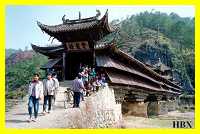
Longyan Links: ![]() Hakka
Roundhouses
Hakka
Roundhouses ![]() Roundhouse Photo Album
Roundhouse Photo Album ![]() Amoy
Tigers
Amoy
Tigers ![]() Changting
(5 Pages!) text and 100+ photos on "Little Red Shanghai", Long
March, Hakka Homeland, etc.)
Changting
(5 Pages!) text and 100+ photos on "Little Red Shanghai", Long
March, Hakka Homeland, etc.) ![]() Guanzai
Mountain (Surrealistic scenery!)
Guanzai
Mountain (Surrealistic scenery!)
Journey to
the West! West Fujian is one roller
coaster range of mountains after another, but it’s well worth the ride
to the Hakka Earthen Houses (about
20,000 of them, altogether!), and “Little
Red Shanghai—” the Hakka Homeland, Cradle of Chinese Communism, and
start of the Long March (followed by the Short April ). 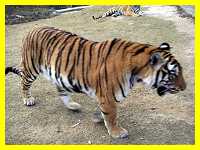
South China tigers (a.k.a. Amoy tigers) roam
Meihua Nature Preserve, and the subterranean beauty of Dragon Cave and
the Immortal Lake Cave compete with the surrealistic scenery of Guanzai
Mountain above.
The six hour drive from Amoy to Changting
winds past ancient villages and banyans (the ‘fengshui tree’ ) nestled
deep within dark valleys shrouded by mists and time. Old stone bridges
irrigate patches of sweet potatoes, tobacco, and taro, guarded by colorful
scarecrows (with crows often perched right on their shoulders).
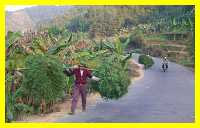 Mysterious
temples cling precariously to cliffs, pagodas crown bald peaks, and solitary
bamboos tower here and there like giant brushes painting the mist on mountains
lifted straight from a Chinese watercolor.
Mysterious
temples cling precariously to cliffs, pagodas crown bald peaks, and solitary
bamboos tower here and there like giant brushes painting the mist on mountains
lifted straight from a Chinese watercolor.
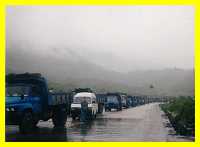 Back
to top Amoymagic Guide to Xiamen
and Fujian
Back
to top Amoymagic Guide to Xiamen
and Fujian
“Don’t
view flowers on horseback!” Chinese warn. (走马观花, zouma
guanhua). In other words, “Take time to smell the roses”(or the nightsoil,
as the case may be). So I prefer to drive slowly (relatively) and savor
the sites. I ignore the honks behind me because I know that Darwinian
Driving (Survival of the Fastest) and Sunzi’s
Art of Auto Warfare (孙子汽车兵法) require
they pass me anyway, whether I’m driving 50 kph or 150 kph. But at least
such driving helps keep the 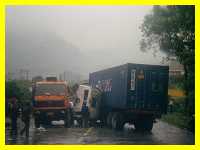 population
down.
population
down.
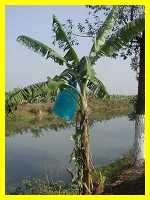 Endless
seas of banana trees fill the valleys west of Zhangzhou.
Zhangzhou bananas are no cheaper here
than in Xiamen but they’re so fresh that one stalk included a pair of
field mice, at no extra charge. Zhangli would have had kittens if he’d
known that our cat Charlemagne got to them.
Endless
seas of banana trees fill the valleys west of Zhangzhou.
Zhangzhou bananas are no cheaper here
than in Xiamen but they’re so fresh that one stalk included a pair of
field mice, at no extra charge. Zhangli would have had kittens if he’d
known that our cat Charlemagne got to them.
Past the bright red and white cottages of “China Orchid Garden (中国兰花园)”
begin the endless villages, temples, ancient banyan trees, and the endless
billboards that help entertain bored Bills.
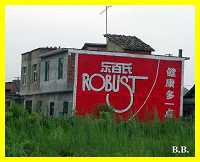 Billboards
and slogans
painted on old walls, buildings, and farmhouses once proclaimed, “Long
Live the Victorious Struggle of the People!” Nowadays they exhort citizens
to “Have one child!” “Cherish the Roads,” “Help Fight Fires,” or
“Drink HuiQuan Beer!” Bright red “Robust!” mineral water signs adorned
buildings in even the remotest valleys. They reminded me of the “See
Rock City! ” barn roofs once scattered all over the Southeastern U.S.
Billboards
and slogans
painted on old walls, buildings, and farmhouses once proclaimed, “Long
Live the Victorious Struggle of the People!” Nowadays they exhort citizens
to “Have one child!” “Cherish the Roads,” “Help Fight Fires,” or
“Drink HuiQuan Beer!” Bright red “Robust!” mineral water signs adorned
buildings in even the remotest valleys. They reminded me of the “See
Rock City! ” barn roofs once scattered all over the Southeastern U.S.
Back to top Amoymagic
Guide to Xiamen and Fujian
Gold and Gall! Longyan is
a geological gold mine, boasting South China’s largest deposit of iron,
as well as gold, manganese, tungsten, and deng deng.
In addition to mining and agriculture (tobacco is the biggest crop, fertilized
by lots of dung dung ), West Fujian is into electronics, metallurgy, machinery,
forestry, building materials, chemicals, textiles, food, and light industries.
The area exports handmade paper, rabbit fur, pepper, dried mushrooms,
smoked plums, and peanuts. But the big claim to fame is Wuping County’s
dried pig gallbladder. The brochure claims,
“Dried pig gallbladder contains
various carbohydrates and vitamins, especially it is the best gift and
delicious dish to be given or to entertain guests and friends with.”
It would take a lot of gall to dish that out to friends, but if you’ve the guts , go for it.
A
Dog’s Life (A She Minority Legend) I swerved to avoid
a hound in the highway and my friend said, “The She worship dogs as gods.”
“I know,” I said. “And I almost sent that god back to heaven!”
Legends claim that an ancient king offered his daughter in marriage to
whomever could save the village from bandits—never dreaming a dog would
win the pretty prize. He didn’t want a dog for a son-in-law, so he used
a 7-day magic transformation to turn the mutt into a man. But on the last
night the curious King took a peek. The magic stopped, leaving a man with
a mutt’s head. Ever since, the She have worshipped dogs, and would no
more eat a dog than other Chinese would chow down on boiled Buddha.
Hakka also worship
dogs, but preferably puppies, ten pounds or less, in a pot. During the
1930s, some soldiers sold their blankets (and probably pup tents as well)
for a hot pot of potatoes ‘n puppy. A hot Hakka dish today is QiLing
TouTai—“Unicorn pokes out his head” (puppy steamed in a pig’s stomach).
Yum. Back to top Amoymagic
Guide to Xiamen and Fujian 
Highway
Heaven Fujian’s modern highways are shrinking our convoluted
province faster than Chinese jeans washed in hot water. Highways bore
through mountains and arch across deep valleys. And every meter is meticulously
manicured with grass, shrubs, bougainvillea, azaleas, a kaleidoscope of
potted plants, and “Cherish the Greenery!” signs. I love the new highways.
They are a real contrast from the dirt roads common only a decade ago!
But they fly right past delightful little towns like Shizhong (适中),
about 170 km west of Xiamen.
Shizhong’s plain has some fascinating 4-story rammed-earth Hakka Castles.
These aren’t tourist traps. Real people live and work here, and when
you show up on their doorstep they’ll grin and say, “You’ve come! Have
some tea!” You might as well sit down because they’re going to keep
offering it until you do! 
1929
Gutian Conference Center 古田会议旧址 Mao was in West
Fujian (Minxi), the “Holy Land of Chinese Communism,” when he penned,
“A single spark can start a prairie fire!” But it was one heck of a
spark!
Recently, the author of “Culture and Landscapes of West Fujian” wrote
this pulse-pounding paragraph:
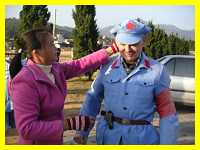 “Nowadays,
step into Minxi this
“Nowadays,
step into Minxi this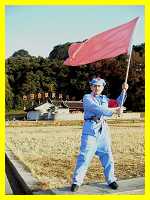 sacred land, tracing the footprint of revolution herald, and we still
can feel the warm of kindling which set the prairie of ablaze and touch
the pulse of revolution struggle which was blistering the heaven, boiling
the mountains, and shaking heaven and earth and taste indeed that the
revolution leader and the herald they rushed around, searched about and
conquered numerous difficulties and endured
all kinds of hardships and die for nations and natives with a generosity.”
sacred land, tracing the footprint of revolution herald, and we still
can feel the warm of kindling which set the prairie of ablaze and touch
the pulse of revolution struggle which was blistering the heaven, boiling
the mountains, and shaking heaven and earth and taste indeed that the
revolution leader and the herald they rushed around, searched about and
conquered numerous difficulties and endured
all kinds of hardships and die for nations and natives with a generosity.”
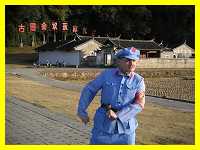
In Dec. 1929, the
Fourth Red Army held its conference in an elementary school (which is
why they call Maoism a ‘school’ of thought). This school was originally
built in 1848 as the Liao family’s ancestral hall. The sign above the
school reads, “The Eternal Radiance/Glory of the Gutian Conference"
(古田会议永放光芒.). The nearby Gutian Congress Exhibition Hall, Fujian’s
largest revolutionary museum, was built in 1974 and has over 7,303 historical
relics—not including the relic selling entrance tickets.
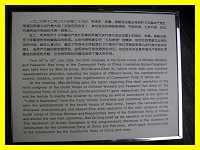


Back to top Amoymagic
Guide to Xiamen and Fujian
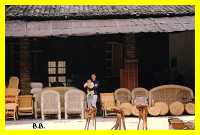 Bamboozled
An elderly couple waved as I passed, and
Bamboozled
An elderly couple waved as I passed, and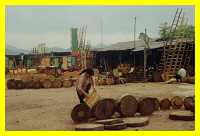 I wondered where they got their beautiful bamboo rocking chairs. I got
my answer a few kilometers down the road.
I wondered where they got their beautiful bamboo rocking chairs. I got
my answer a few kilometers down the road.
Between Longyan and Pengkou (about the 266 km. marker), roadside vendors
display an astonishing variety of wood, bamboo and rattan products. They
sell everything from 50-cent bamboo stools to bamboo mattresses, car seat
covers, couches, chairs and tables, massive cutting boards, and artistic
root sculptures (which are also found south of Wuyi
Mountain). On sheets of black plastic beside the highway are strips
of Longyan’s famous sweet potato, drying in the sun.
Fortunately, the dried sweet potato sold in stores is usually 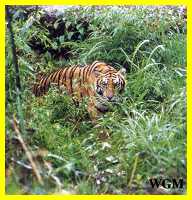 packaged
in hygienic factories.
packaged
in hygienic factories.
The Meihua Mountain
(梅花山) Nature Reserve is a wonderland
of waterfalls, rolling wooded hills, strange peaks, and breathtaking caverns,
and is home to almost 1500 kinds of plants and hundreds of varieties of
reptiles, birds, and animals, including 40 endangered species like leopards,
black bears, and rare South China tigers.
(Click for photos of these tigers!)
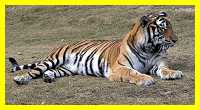 In
August, 2000, Longyan launched a $17.6 million USD (donations appreciated!)
tiger protection project because less than 30 remain in the wild, and
only 59 in zoos. They hope that by 2010, the six protected tigers will
have bred and raised the population to 100. I don’t see how six tigers
can do that unless they spike their food with Viagra. But on July 20,
2001, Zhongzhong and Qiuqiu were born to Yuanyuan and Xiongxiong.
In
August, 2000, Longyan launched a $17.6 million USD (donations appreciated!)
tiger protection project because less than 30 remain in the wild, and
only 59 in zoos. They hope that by 2010, the six protected tigers will
have bred and raised the population to 100. I don’t see how six tigers
can do that unless they spike their food with Viagra. But on July 20,
2001, Zhongzhong and Qiuqiu were born to Yuanyuan and Xiongxiong.
Good good start start!
Back to top Amoymagic
Guide to Xiamen and Fujian
Longkong
Caverns (龙硿洞) When I visited Yanshi Town’s Long Kong
Caverns 15 years ago, the only illumination was our guide’s flashlight,
which died 2/3 of the way through the tour. As we held hands and slipped
and slid through the caverns inky depths I vowed, “Never again!” But
today the caverns are well developed, well lit, and well worth the 48
km drive from Longyan City. The caverns include 14 smaller caves. The
largest cavern is 20 m high, 50 m wide, and can hold 1,000 people (provided
they’ve had a light lunch).
Three
“Immortal Doors”
are in the front cave. One door leads to certain death. Just kidding.
The middle door leads to the Stone Elephant and the Stone Bed. They say
the Stone Bed is restful, but I thought it was hard and damp, like a petrified
waterbed. But it probably beats the ‘room and board’ I’ve gotten in
some local hotels.
Like everywhere else in China, locals have whiled away the past 5,018
years (Click Here for explanation of 5018 years) by
naming every rock, nook, and cranny, both above ground and below. LongKong
Caverns has Stone Frog Leaping into Pond, Guanyin goddess, Most Exalted
Lord Lao, and Running Horse, where dripping water supposedly sounds like
hoof beats. The most striking formation is the Stone Bells, which ring
if you strike them. Other favorites include Spring Plowing, River Snails,
Wax Gourd, Bamboo Grove (in Jade Cave), Boa, Flying White Dragons, Cloth
Curtains, and the Yellow Umbrella, which might provide shelter from the
dripping horse.
Back to top Amoymagic
Guide to Xiamen and Fujian
Subterranean Immortal Lake (仙湖) in Yongding’s Fushi Town is little known but nonetheless spectacular. The underground complex has dozens of halls, and the ten-meter-high hall, “Dragon’s Palace in the Western Sea” covers 10,000 square meters. Tourists are ferried to the subterranean sea’s center to see a 10 m high column that is strikingly similar to Long Kong’s Stone Bells because it rings when struck.
Zhangping’s
Yongfu Flower Town (永福),
originally a She stronghold, really blooms during the Flower Fair on the
6th day of the Chinese New Year. At 755 meters elevation, this ancient
town enjoys the perfect climate for raising exotic fruit like tangerines
and honey peaches, and the hundreds of varieties of flowers (like camellias,
orchids and azaleas) sold throughout China and other Southeast Asian countries.
Yongfu is also famous for its bamboo hats, beautifully wrought rattan
furniture, and its own unique style of paper-cuts, a folk art found throughout
China.
Yongfu historical attractions include the Aotou Porcelain Site, Liuxiu
Tower, Changqing Castle, Huigong Bridge, and Buyun Bridge.
Back to top Amoymagic
Guide to Xiamen and Fujian
Friend’s Crossing (朋口, Pengkou), just south of Longyan, is a “T” intersection thronged with vendors and a few dozen men lazing on motorcycles—the rural version of taxis. A grandpa leading his water buffalo and calf up the middle of the highway ignores honking drivers. He knows that if you hit his animals, he’ll retire on the settlement. If you kill the farmer himself, his family will retire and worship his remains at the ancestral shelf.
To
Pengkou’s left lies Changting, the
“Little Red Shanghai. To the right
is lovely Liancheng’s Guanzai Mountain,
one of China’s star scenic attractions. Liancheng was also home to one
of ancient China’s four greatest printing centers.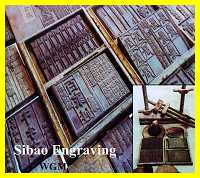
Sibao Woodblock
Printing
West Fujian had forests of camphor for printing blocks, and endless bamboo
reserves for the famous papers made in Ninghua,
Changting, and Liancheng as early as the 11th century. Burned pines
produced soot for ink. Date palm fibers and mountain animals’ fur provided
brushes. The pieces to the printing industry puzzle were all there, but
it still came together almost by accident.
Back to top Amoymagic
Guide to Xiamen and Fujian
Chinese invented ‘rag paper’ around 2,100 years ago, and the
Arabs learned the process from their prisoners in the 8th century (Europeans
learned these same secrets about the 12th century). Around 1045 A.D.,Bi
Sheng invented movable type. Give that Chinese uses thousands of characters,
the typesetting must have been a real chore. Personally, I’d not have
the patience for it. I’m just not that type.
In the 16th century, Zou Xuesheng (1523-1598) printed some texts to educate
his sons, and they in turn produced and sold texts to various schools—creating
the Sibao printing industry.
By the late 1700s, over 100 families (60% of some villages’ populations)
produced and sold books. The Zou and Ma families’ presses produced over
1,000 books, including Emperor Kangxi’s Dictionary, the Four Classics,
the Children’s Treasury of Knowledge, as well as various encyclopedias,
almanacs, and fengshui manuals. But the city was so remote that it remained
relatively obscure. Some printing magnates’ mansions remain today, most
printing stalls are now pigpens or storage bins.
While Sibao’s books have vanished, the inspiration for many a poet remains—in
nearby Guanzai Mountain.
Back to top Amoymagic
Guide to Xiamen and Fujian
The Chengang
Wine (沉缸酒) Factory, established in 1957 in Longyan, just off
the 319 Highway, is well worth a visit. I’ve toured the place thrice,
and while the speeches can be murder by monologue, the factory tour is
fascinating. The Apostle Paul may have meant Chengang Wine when he urged
young Timothy to no longer drink water but take a little wine for his
stomach’s sake. The 200-year-old recipe for Chengang Wine has 31 Chinese
medicines that cure anything that ails you, and a few things that don’t.
The 500 employees and 96 technicians put out 10,000 tons of the sweet
yellow wine each year.
Address: #78 Shuangquan Rd., Xinluo District, Longyan.
Phone: (0597)221-1222.
A Xiamen
University professor told me China had 5000 years of history--but that
was 18 years ago.
![]() Favorite
Fujian Sites
Favorite
Fujian Sites ![]() Fujian
Foto Album
Fujian
Foto Album ![]() Xiamen
Xiamen
![]() Gulangyu
Gulangyu
![]() Fujian
Guides
Fujian
Guides ![]() Quanzhou
Quanzhou
![]() Zhangzhou
Zhangzhou
![]() Longyan
Longyan
![]() Wuyi
Mtn
Wuyi
Mtn ![]() Ningde
Ningde
![]() Putian
Putian
![]() Sanming
Sanming
![]() Zhouning
Zhouning
![]() Taimu
Mtn.
Taimu
Mtn. ![]() Roundhouses
Roundhouses
![]() Bridges
Bridges
![]() Jiangxi
Jiangxi
![]() Guilin
Guilin
![]() Order
Books
Order
Books![]() Readers'
Letters
Readers'
Letters
Last Updated: May 2007
![]()
DAILY
LINKS
![]() FAQs
Questions?
FAQs
Questions?
![]() Real
Estate
Real
Estate
![]() Shopping
Shopping
![]() Maps
Maps
![]() Bookstores
Bookstores
![]() Trains
Trains
![]() Busses
Busses
![]() Car
Rental
Car
Rental
![]() Hotels
Hotels
![]() News
(CT)
News
(CT)
![]() Medical
& Dental
Medical
& Dental
![]() YMCA
Volunteer!
YMCA
Volunteer! ![]()
![]() XICF
Fellowship
XICF
Fellowship
![]() Churches
Churches
![]()
![]()
![]() Temples
Temples![]()
![]() Mosque
Mosque
![]() Expat
Groups
Expat
Groups
![]() Maids
Maids
![]() Phone
#s
Phone
#s
EDUCATION
![]() Xiamen
University
Xiamen
University
![]() XIS(Int'l
School)
XIS(Int'l
School)
![]() Study
Mandarin
Study
Mandarin
![]() CSP(China
Studies)
CSP(China
Studies)
![]() Library
Library
![]() Museums
Museums
![]() History
History
DINING
![]() Restaurants
Restaurants
![]() Asian
Asian
![]() Veggie
Veggie
![]() Junk
Food
Junk
Food
![]() Chinese
Chinese
![]() Italian
Italian
![]() International
International![]()
![]() Visas
4 aliens
Visas
4 aliens
RECREATION
![]() Massage!
Massage!
![]() Beaches
Beaches
![]() Fly
Kites
Fly
Kites
![]() Sports
Sports
![]() Boardwalk
Boardwalk
![]() Parks
Parks
![]() Pets
Pets
![]() Birdwatching
Birdwatching
![]() Kung
Fu
Kung
Fu ![]() Hiking
Hiking
![]() Music
Events
Music
Events
![]() Festival&Culture
Festival&Culture
![]() Humor&
Humor&![]() Fun
Fotos
Fun
Fotos![]()
BUSINESS
![]() Doing
Business
Doing
Business
![]() Jobs!(teach/work)
Jobs!(teach/work)
![]() Hire
Workers
Hire
Workers
![]() Foreign
Companies
Foreign
Companies
![]() CIFIT
(Trade Fair)
CIFIT
(Trade Fair)
![]() MTS(Translation)
MTS(Translation)
![]()
Back to Top





